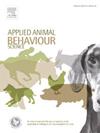Poor welfare indicators may be associated with performance limitations in racehorses
IF 2
2区 农林科学
Q1 AGRICULTURE, DAIRY & ANIMAL SCIENCE
引用次数: 0
Abstract
Welfare is defined as the state of an animal, which includes both its emotional and physical condition. Monitoring it for racehorses is of fundamental importance to prevent poor welfare, which is deleterious to the animal's integrity but might also affect performance. This study aims to evaluate the welfare of French racehorses, and to explore potential links between compromised welfare and race placing. 52 trotters and 32 gallopers were evaluated for welfare using the AWIN horse protocol with behavioural observations using the scan sampling method in order to detect abnormal behaviours (stereotypies, alert posture, inactivity or other abnormal behaviours). The horses' race placing was also recorded for a six-month period around the study (percentage of races in which the horse finished in the top three, in the top five or in which it was disqualified (trotters)). Linear models were constructed to identify significant horse-centred welfare indicators affecting race placing. Results demonstrated a discrepancy in the welfare indicators evaluated in the two populations of horses, especially for environmental indicators that indicate a more restrictive management in gallopers than trotters in terms of social interactions and frequency of free exercise. Furthermore, the study identified risk variables associated with racehorses' welfare, including mouth corner lesions, which were observed in 23.1 % of trotters and 18.8 % of gallopers. Additionally, 40.4 % of trotters and 25.0 % of gallopers exhibited limb skin lesions. The prevalence of these four abnormal behaviours was observed across both groups, with percentage observations ranging from 0.3 % to 3.5 % across the scans. The results also identified a negative relationship between inactivity and finishing positions in trotters for the three race placing indicators (linear models; p < 0.05), emphasising the importance of this behaviour in evaluating their welfare and finishing positions. No such correlation was observed in gallop horses. Further research is needed to explore the complex relationships between welfare, including concepts like positive mental states and enjoyment, and racehorses’ race placings.
较差的福利指标可能与赛马的表现限制有关
福利被定义为动物的状态,包括它的情感和身体状况。对赛马进行监测对于防止福利不佳至关重要,福利不佳不仅会损害动物的完整性,还可能影响其表现。本研究旨在评估法国赛马的福利,并探讨福利受损与比赛排位之间的潜在联系。使用AWIN马方案对52匹快马和32匹快马进行福利评估,并使用扫描抽样方法进行行为观察,以检测异常行为(刻板印象、警觉姿势、不活动或其他异常行为)。在研究期间,这些马的比赛名次也被记录了六个月(这匹马在前三名、前五名或被取消资格的比赛中的百分比)。建立了线性模型,以确定影响赛马排名的显著以马为中心的福利指标。结果表明,两种马的福利指标存在差异,特别是环境指标表明,在社会互动和自由运动频率方面,对飞马的管理比对马步的管理更严格。此外,该研究确定了与赛马福利相关的风险变量,包括嘴角病变,在23.1% %的快步马和18.8% %的疾驰马中观察到。此外,40.4% %的快步马和25.0% %的疾驰马表现出肢体皮肤病变。这四种异常行为的患病率在两组中都被观察到,在扫描过程中观察到的百分比范围从0.3 %到3.5 %。结果还发现,在三项比赛排名指标中,不运动与终点位置之间存在负相关关系(线性模型;P <; 0.05),强调了这种行为在评估他们的福利和最终排名中的重要性。在奔马身上没有观察到这种相关性。福利(包括积极的心理状态和享受等概念)与赛马的名次之间的复杂关系需要进一步的研究。
本文章由计算机程序翻译,如有差异,请以英文原文为准。
求助全文
约1分钟内获得全文
求助全文
来源期刊

Applied Animal Behaviour Science
农林科学-行为科学
CiteScore
4.40
自引率
21.70%
发文量
191
审稿时长
18.1 weeks
期刊介绍:
This journal publishes relevant information on the behaviour of domesticated and utilized animals.
Topics covered include:
-Behaviour of farm, zoo and laboratory animals in relation to animal management and welfare
-Behaviour of companion animals in relation to behavioural problems, for example, in relation to the training of dogs for different purposes, in relation to behavioural problems
-Studies of the behaviour of wild animals when these studies are relevant from an applied perspective, for example in relation to wildlife management, pest management or nature conservation
-Methodological studies within relevant fields
The principal subjects are farm, companion and laboratory animals, including, of course, poultry. The journal also deals with the following animal subjects:
-Those involved in any farming system, e.g. deer, rabbits and fur-bearing animals
-Those in ANY form of confinement, e.g. zoos, safari parks and other forms of display
-Feral animals, and any animal species which impinge on farming operations, e.g. as causes of loss or damage
-Species used for hunting, recreation etc. may also be considered as acceptable subjects in some instances
-Laboratory animals, if the material relates to their behavioural requirements
 求助内容:
求助内容: 应助结果提醒方式:
应助结果提醒方式:


